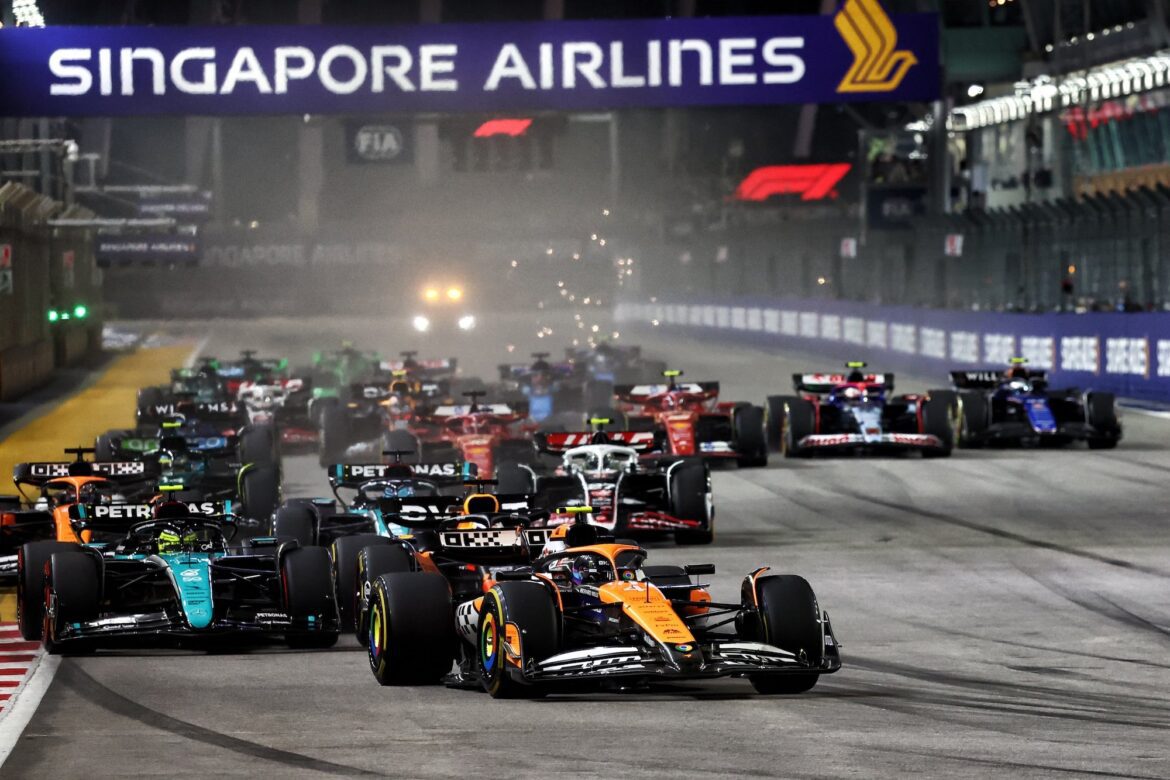The 2025 Singapore Grand Prix: A New Level of Challenge for Formula 1
The Singapore Grand Prix has long been recognized as one of the toughest endurance tests in the world of Formula 1 racing. However, the upcoming 2025 edition is set to raise the stakes significantly. Predictions indicate that the drivers will face a punishing combination of soaring temperatures, oppressive humidity, and the possibility of heavy rainfall throughout the weekend at the Marina Bay Circuit.
Extreme Weather Conditions Ahead
As the event approaches, the weather forecast suggests that teams and drivers will have to navigate through some of the most challenging conditions imaginable. The first two practice sessions on Friday will serve as a precursor to the extreme climate they will contend with. During the first practice session (FP1), temperatures are expected to climb to around 32°C (approximately 90°F), accompanied by humidity levels reaching 80%. This combination will lead to a feel-like temperature exceeding 37°C (98.6°F). Such conditions can be likened to being in an oven, especially within the tight confines of the cockpit, where airflow is limited and heat can accumulate rapidly.
In the second practice session (FP2), even though temperatures may drop slightly to 28°C (82°F), the high humidity will persist, and there is a significant risk of thunderstorms. These weather fluctuations can create an unpredictable environment for the teams as they work to fine-tune their setups and strategies.
Saturday’s Dry Spell with a Rainy Outlook
On Saturday, the forecast suggests a drier track for the day’s activities, although rain is still a possibility in the morning and early afternoon. The third free practice session (FP3) may witness drivers experiencing a feel-like temperature of around 39°C (102.2°F). While the likelihood of rain during the qualifying session appears to be lower, the extreme heat will remain a factor for the competitors.
The combination of high temperatures and humidity will require drivers to maintain peak physical and mental performance. Many athletes in this sport are accustomed to losing several pounds during a race due to sweat, necessitating aggressive cooling strategies and ice baths to combat the toll the heat takes on their bodies.
Race Day: A New Set of Challenges
As the race day approaches, the weather forecast takes another turn, but unfortunately, not for the better. While rain is expected earlier in the day, drivers will find themselves racing in approximately 28°C (82°F) with a feel-like temperature of 37°C (98.6°F) and humidity hovering around 74%. This combination of factors will create a grueling environment, particularly on the narrow and winding track, where airflow is limited.
Singapore’s street circuit is notorious for demanding absolute precision from drivers, and the adverse weather conditions can quickly drain both focus and energy levels. With the added physical strain of the heat, drivers must be in peak condition to withstand the rigors of the race.
The Unique Challenges of the Marina Bay Circuit
The Marina Bay Circuit is well-known for its complexity and technical challenges. It features tight corners and limited overtaking opportunities, making it crucial for drivers to execute flawless laps. The combination of the circuit’s design and the anticipated weather conditions will test even the most skilled and seasoned drivers.
One of the critical aspects that teams will need to consider is how to manage tire degradation. Hot and humid conditions can lead to increased tire wear, and teams will need to strategize on when to pit for fresh tires to maintain optimal performance throughout the race.
The Physical Demands on Drivers
As the temperatures soar, the physical demands on drivers become even more pronounced. In addition to managing their cars, they must also focus on staying hydrated and keeping their body temperatures in check. Dehydration can lead to decreased reaction times and impaired judgment, which could be detrimental in a high-speed race environment.
To cope with the extreme conditions, drivers often engage in rigorous physical training and develop personalized hydration strategies. Some may even employ cooling vests and other equipment to help regulate their body temperatures before and during the race.
The Impact of Humidity on Performance
Humidity plays a significant role in how drivers perform, especially in a tropical climate like Singapore’s. High humidity levels can lead to increased fatigue and can affect a driver’s concentration and decision-making abilities. As the race progresses, maintaining mental clarity becomes as critical as physical endurance.
Furthermore, the humidity can also impact the car’s performance. Teams will need to consider how the air density affects engine performance and downforce, making adjustments to their setups accordingly.
Strategies for Success
With the unique challenges presented by the 2025 Singapore Grand Prix, teams will need to develop comprehensive strategies that account for the weather conditions. This includes assessing tire choices, pit stop timing, and cooling techniques for both the drivers and their cars.
Teams will also need to be prepared for the unexpected. Weather patterns in tropical climates can change rapidly, and being able to adapt to these changes could be the key to success. Engineers will be closely monitoring the forecasts and adjusting their strategies in real-time to ensure they are ready for any scenario.
Conclusion: A Race for the Ages
The 2025 Singapore Grand Prix promises to be an unforgettable event, pushing the limits of both drivers and teams to new heights. With the combination of extreme weather conditions, the challenging Marina Bay Circuit, and the physical demands placed on competitors, this race will undoubtedly test the mettle of everyone involved.
As fans eagerly anticipate the action, the excitement builds for what could be one of the most thrilling and intense races in Formula 1 history. The drivers will need to bring their A-game, and the teams will have to be at their best to navigate the challenges that lie ahead.
